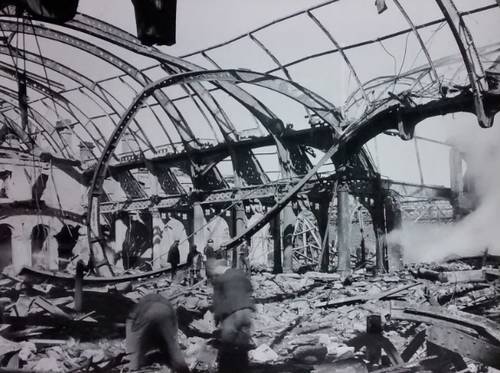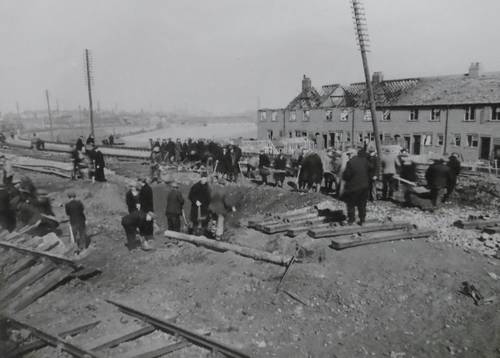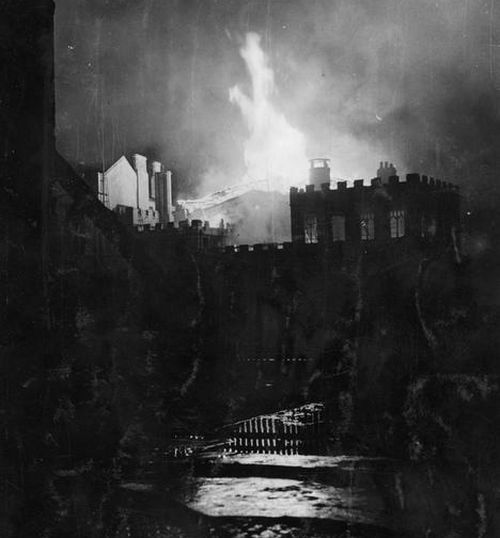Through the city
The Railway Station and surrounding sidings and sheds were a main target and these were hit by both incendiary and high explosive bombs which caused major fires and inflicted serious damage. A large part of the station roof was brought down, the booking hall, records office, tea rooms were burnt out and the tracks were covered with rubble.
Click this link for a full list of station buildings that were destroyed
Two civilians died in the station and the damage to railway property was calculated as £376,400.
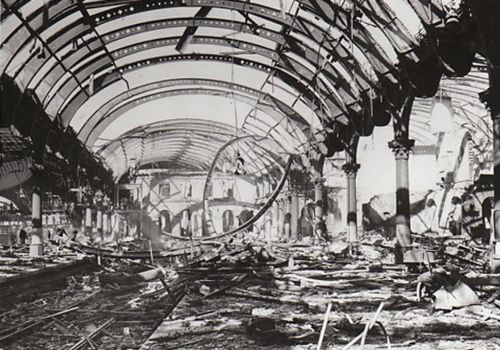
The station's metalwork twisted by heat and shattered by high explosives.....image shows the damage around platforms 1, 2 & 3.
(Picture reproduced courtesy of The Press, York......www.thepress.co.uk)
Another view of the damage inflicted on the railway station.
(Picture reproduced courtesy of The Press, York......www.thepress.co.uk)
There were dramatic scenes in the station that night as a twenty coach train was waiting at platform 9. The train left London at 22:15hrs on its way to Edinburgh and had the misfortune to arrive (29 minutes late) in the York area just as the sirens sounded and German ordnance started to fall.
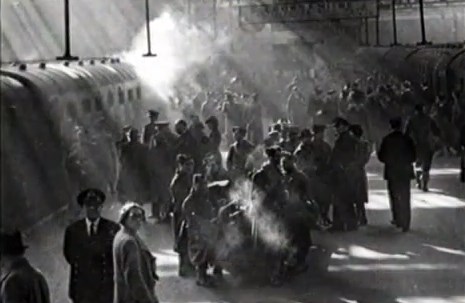
Troop trains were a common sight in York (photograph is from an earlier month).
Image credit: Still from "The Longest Night" video.
The Assistant Station Master and Station Inspector advised the weary passengers to take cover. However, many were worried about their luggage and were reluctant to leave the train. A bomb then landed in the nearby sidings and blew rails over the "Up & Down Main Passenger Lines". The train was then quickly evacuated. About one minute later a large number of incendiaries fell onto the station roof and onto the London-Edinburgh train. Shunters split the burning train into thirds and pulled clear fourteen undamaged carriages from the front and rear leaving the remaining six central coaches to burn themselves out.
The remaining burnt out carriages of the express train alongside platform 9 in York Station.
This incident attracted negative comments and was discussed at the highest level.
Image copyright of the National Archives.
Click this link for detailed reports concerning the "Troop Train Incident" incident.
York Engine Shed consisted of a large buidling with four turntables and, on the night of the raid, held about 50 engines.
A 500kg bomb (designated no:54) landed in No:4 Shed in the middle of three locomotives which acted as a shield for the other engines. Two of the three engines were very seriously damaged but the third was able to be repaired. A further eighteen engines were damaged. Over the next four days all the engines in Sheds 1,2,3 & 4 were removed from the damaged area.
Additionally, in the railway area, sixty-six coaches and wagons were destroyed and four hundred and thirty-six damaged.
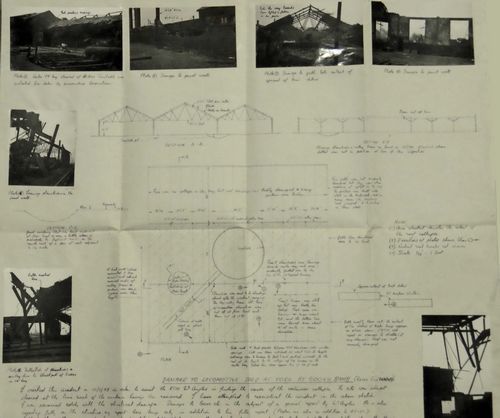
A handwritten report with photographs exists which shows, in great detail, the damage done by the single 500kg bomb.
Image copyright of the National Archives.
An A-4 locomotive named Sir Ralph Wedgwood was totally destroyed.
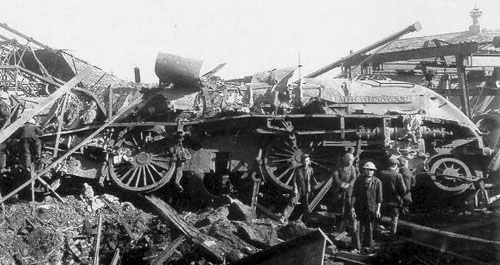
Sir Ralph Wedgwood lying on its side outside York North MPD (Motive Power Depot).
(Picture reproduced courtesy of The Press, York......www.thepress.co.uk)

A brief damage report on Sir Ralph Wedgwood......there was a further report which went into the greatest detail, and example being....."the right hand reversing gear arm, radius rod, combination lever and union link need replacement."
Document copyright of the National Archives.
The railway lines in and out of the York station area were a target and were hit in fifteen locations. Surprisingly little damage was done to the lines which were quickly repaired.
The photograph shows the bomb damaged tracks at the rear of the houses on Garfield Terrace in the Leeman Road enclave.
All tracks were repaired by midnight on May 1st.
Image copyright of the National Archives.
The records state that "the railway station, railway yards and their related buildings occupy an area of 246 arces or 0.384 square miles. Approximately 87% of this area is covered by railway track.
16% by number and 18% by weight of the total high explosive dropped fell within the railway area. The intensity of the attack, 23 tonnes per square mile, is five times greater than for the whole city and slightly greater than Clifton and Holgate, the two most heavily bombed wards of York. It is therefore not clear whether the centre of York or the railway system only was the object of the attack."
Several accounts now refer to the attacks on Coney Street. This street contained the HQ of the Civil defence in the Guildhall and the secret HQ of the Royal Observer Corp behind the Post Office. It also ran parallel to the River Ouse which was bordered by several warehouses and had the misfortune to be only a few hundred metres east of the railway station.
Whether the street was the intended target or just the unfortunate recipient of stray bombs is open to conjecture.
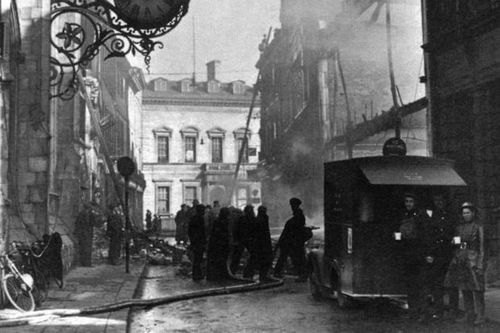
Fire fighters tackle blazes along Coney Street.
(Picture reproduced courtesy of The Press, York......www.thepress.co.uk)
Click this link to view details of the number of firefighters and available equipment
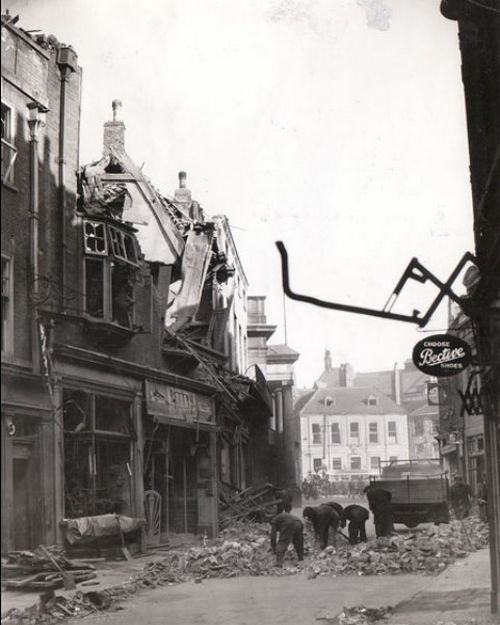
Damage on nearby Blake Street.
(Picture reproduced courtesy of The Press, York......www.thepress.co.uk)
There was a great deal of destruction in this area; riverside warehouses were demolished and the Rowntree's sugar store burnt fiercely.

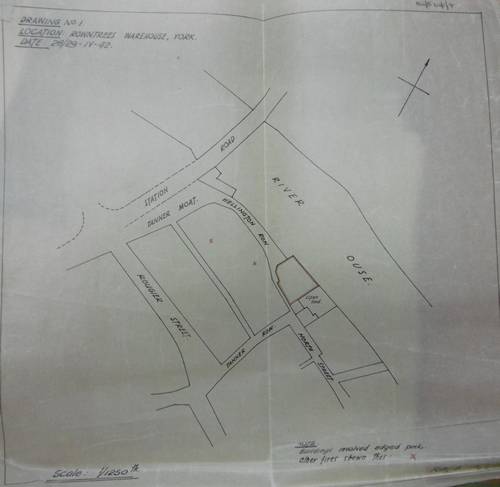
The site of Rowntree's warehouse on North Street following its destruction and loss of over 400 tons of sugar and cocoa beans.
Photograph and plan are copyright of the National Archives.
The magnificent Guildhall and the Church of St Martin le Grand were burnt out. The ARP HQ was at the rear of the Guildhall and had to be evacuated.
The Guildhall ablaze ( © York City Archives)
The most important damage to services in the city was the collapse of the whole telephone system. Two small fires started in the telephone exchange and the water and chemicals used to extinguish this, together with a large quantity of water which poured in from Guildhall nearby, shorted all the cables in the telephone exchange.
A report states that, "it was obvious that all concerned wished to minimise the incident as much as possible and that it had not been a major disaster."
The author of the report remarks that, "since there had been no implication that it was [a major disaster] it appears as if the Area Supervisor regarded it in that light."
The breakdown occurred at 03:25hrs and, after a massive effort, the entire system was fully functioning again at 07:30hrs on Thursday 7th May.

St Martin le Grand in Coney Street was badly damaged in the raid.
(Picture reproduced courtesy of The Press, York......www.thepress.co.uk)

Dampening down the fire which destroyed St Martin le Grand.
During the night of the raid an estimated 1,750,000 gallons of water were used (not including dampening down).
(Picture reproduced courtesy of The Press, York......www.thepress.co.uk)
As late in the raid as 04:06hrs (the 'All Clear' was 04:17hrs) incendiary bombs were being dropped very wide of the mark between Belthorpe and Fangfoss (ARP reports no: 3581).

There were 67 serious incidents and 58 major fires.
109 people (householders, civil defence and military) were killed (see Casualty Summary).
Over 200 were injured to varying degrees and, of the 27,000 houses in the city, 579 were rendered uninhabitable. A further 2,500 were damaged to some extent.
